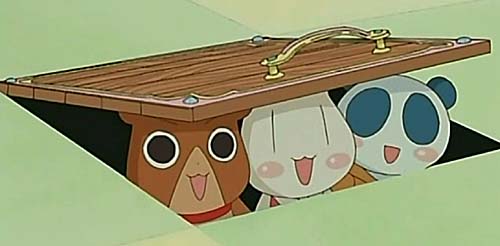
Pine bark.
Trivia that matter

Pine bark.


There’s a wisteria vine I pass when I go to work. In spring every year it becomes a solid wall of lavender. This year, however, the late freeze killed all the buds. The vine has come back, and it has even managed to produce a few racemes, though it’s a pitiful display compared to the usual spectacle. (The camera has difficulty accurately capturing some shades; the flowers are less blue and more violet than in the picture.)
Celestia or Stellarium. (The Macintosh version of latter requres OS 10.4, so I haven’t been able to test it.)
(Via Mark Shea.)
The English-language dub of Sailor Moon is notorious for dumbing down and bowdlerizing the story, but it could have been worse. Much worse.

I don’t think I’ve ever posted a picture of my dulcimer. This was the eighth one I built, back in 1993. It has a cedar soundboard, sixteen treble and sixteen bass courses, and is most playable in keys with a sharp or two.
It could use more bookshelves, and it may offend purists by not actually being a hole in the ground, but otherwise it looks quite habitable.
(Via Domenico Bettinelli.)
Consult Picofarad’s Recurring Convention List.
(Via Lynn S.)
Pythagoras Switch is a science show for small children. Each episode follows the same format. Puppets introduce a video on a such topics as how the shapes of objects are clues to their manufacture or use, or static electricity, or how technology imitates nature. After that, a youngster controls his father or grandfather with a cardboard “father switch.” There is also some very simple animation, and either the “algorithm march” or the “algorithm exercise,” sequences of simple movements performed in canon. Children old enough to read the subtitles are likely to be bored by the very elementary level of most of the show.
What makes Pythagoras Switch worth watching are the Rube Goldberg mechanisms that open and close the show and separate the segments. Here’s a collection of these “Pythagorean devices.”
Here’s the algorithm march, performed by ninjas:
Five episodes that I know of have been subtitled. There’s quite a bit available on YouTube.

There’s a mysterious door in the floor of five-year-old Ami’s room in her family’s new home. It leads to Animal Yokocho, or AniYoko, a parallel universe inhabited by talking animals. Three of the animals pop out of the door every day to play with Ami: Kenta, the high-strung bear; Issa, the gentle panda; and, Iyo, the playful, deranged rabbit. They do things differently in AniYoko:
Via From the Shattered Drum, how to create the Dr. Who theme:
Addendum: Want to play with the cool toys but can’t find or afford the hardware? Consider software emulations, e.g., this and this.
• Hawthorn flowers stink.
* Maxell DVD-Rs are junk. Even if I burn them at half the rated speed, over a quarter of them end up as coasters.

Callirhoe involucrata

While there is no such thing as normal Kansas weather, the past several months have been more bizarre than usual. Fall gave way to spring in early January. Then winter came, followed by spring again in March. Then winter returned in April, abruptly ending the flowering fruit tree season. I noticed today that a flowering crab along my route to work managed to produce a few last flowers.